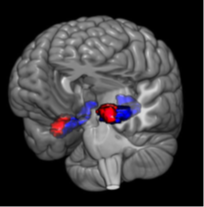Sensitivity to the Childhood Environment is influenced by the Brain
14th January 2022 - By Prof Michael Pluess
About the authors
Prof Pluess is a developmental psychologist and one of the leading authors in the field of Environmental Sensitivity with specific expertise in the development and validation of sensitivity measures besides significant contributions to theories of Environmental Sensitivity. He leads several research projects on sensitivity.
Summary
Theory suggests that differences in sensitivity are due to characteristics of the brain. We conducted a study to test whether certain brain regions predict sensitivity in a sample of boys. We found that boys with a larger amygdala were more sensitive to the quality of their childhood environment.
Study Background
It is well known that children differ in how strongly they are influenced by their experiences. Research studies show that some children are generally more sensitive than others to both negative and positive influences. They suffer more when experiencing adversity such as harsh parenting but do especially well in supportive and caring settings.
Such differences in environmental sensitivity have been associated with various genetic, physiological, and psychological characteristics. However, according to the leading theories of sensitivity the main reason for heightened sensitivity is a brain on which experiences register more easily and more deeply. It is hypothesised that such “neurosensitivity” renders some children more sensitive to their environment.
Several studies found that two specific brain regions, the amygdala and the hippocampus, might be especially relevant for sensitivity. The amygdala is a small and central brain structure that is involved in the processing of emotional information. The hippocampus is also a central brain region but primarily involved in learning and memory. Other brain regions likely play a role for sensitivity as well.
In the current study (1), we investigated whether the amygdala and hippocampus are associated with sensitivity to the quality of the early childhood environment.
Study Design
The study was conducted with existing data from 62 10-13 year-old boys selected from the Twins Early Development Study (TEDS), a large longitudinal study of over 16,000 twins born in England and Wales. The 62 boys represent a subset of children from the TEDS study that took part in a brain-imaging study.
It is possible to measure both the function (i.e., reactivity) of specific brain regions as well as the structure (i.e., volume). In this study we focused on the volume rather than the function. In order to measure volumes of the amygdala and hippocampus, participating boys were scanned in a magnetic resonance imaging (MRI) scanner when they were about 10-13 years old. Given that the brain has two hemispheres, we considered volumes of the left and right amygdala and the left and right hippocampus separately (see Figure 1).
The quality of the environment in the first nine years of the boys’ lives was measured by combining a range of important social and material aspects of their environment, including various parenting practices, socioeconomic status of the family, and household income. The resulting combined scale reflects broad environmental quality from low to high quality (the higher the score the higher the environmental quality).
Finally, the outcome of interest was a measure of child behaviour, including emotional problems, conduct problems, hyperactivity/inattention, peer problems, and prosocial behaviour, completed by teachers when boys were aged 12-13 years. The first four behaviours were combined into a total problem score.
We then tested whether amygdala and hippocampus volumes influenced the effect of early environmental quality on children’s behaviours. According to theory we expected that the effect of the environment on child behaviour would be stronger in some children due to differences in volumes of these brain regions.
Key Findings
According to analyses, the volume of the left amygdala (but none of the other tested brain volumes) was associated with higher sensitivity to the early environment. More specifically, it was the boys with a larger left amygdala that were more sensitive to the effects of early environmental quality.
As shown in Figure 2, boys with a larger left amygdala had more problems when they experienced lower environmental quality in early childhood, but also fewer problems than other boys when environmental quality was high. Additional statistical analyses showed that results were driven by sensitivity to high environmental quality. In other words, boys with a larger left amygdala were particularly sensitive to the positive effects of a high quality environment.
In a second step we also considered the individual rather the combined child behaviours. Interestingly, environmental sensitivity due to larger left amygdala volume was not restricted to problem behaviours. Boys with a larger left amygdala also developed more prosocial behaviours when growing up in an environment of higher quality. In contrast, the quality of the early environment did not predict child behaviour in boys with a small left amygdala.
Conclusion
Our study suggests that a larger amygdala volume, a small brain region involved in the processing of emotions, is associated with heightened sensitivity to the quality of the early childhood environment in boys. Importantly, boys with a larger left amygdala not only had reduced behavioural problems but were also rated by teacher as showing higher prosocial behaviour when experiencing a high quality environment. The hippocampus, on the other hand, was not associated with sensitivity in this study.
Although results have to be considered in light of the fact that the sample was relatively small and included only boys, the study provides further important evidence that sensitivity to the environment is associated with specific characteristics of the brain.
Figure 1

Illustration of the selected brain regions. Left and right amygdala are in red whereas left and right hippocampus are in blue.
Figure 2

References
- Pluess, M., De Brito, S. A., Bartoli, A. J., McCrory, E., & Viding, E. (2020). Individual differences in sensitivity to the early environment as a function of amygdala and hippocampus volumes: An exploratory analysis in 12-year-old boys. Development and Psychopathology, 1-10.
